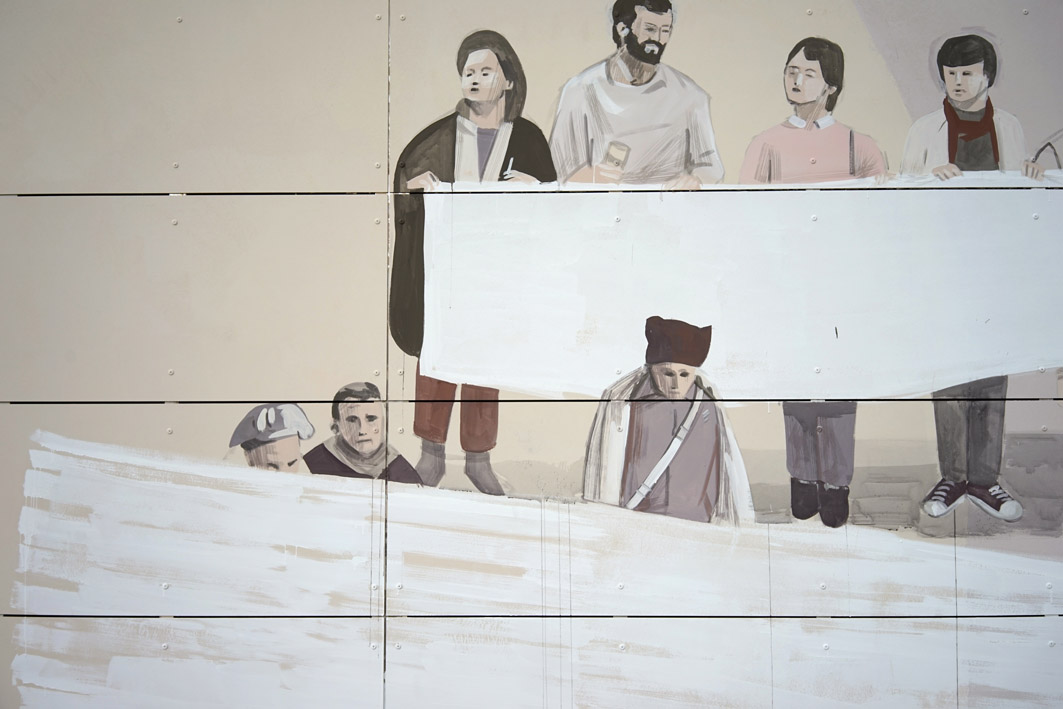
En 1977, se conquistó la plaza de la Salud. Eso cuentan las paredes. Pero no es cierto. La plaza solo era un destello. Lo que realmente se conquistó fue una forma de entender la sociedad que vas más allá de la plaza, más allá de los intereses personales de unos cuantos vecinos y unas cuantas vecinas.
En 1977, los vecinos y las vecinas del barrio de la Salud hicieron una demostración de solidadridad, de unidad, de motivación y entrega, de empoderamiento, de identidad. Se juntaron en un movimiento orgánico y estratégico que se agrupo bajo la consigna de recuperar la plaza… y lo consiguieron.
En 1977, los vecinos y las vecinas de Sant Feliu aprovecharon una fisura en el asfalto para plantar una semilla. Una semilla, que era un árbol, que era una bandera, que era una recuperación del espacio público, que era también una plaza para los y las vecinas. Lucharon por sus derechos. Asentaron las bases de un modelo urbanístico que tenía en cuenta a las personas. Demostraron que la ciudad se construye desde abajo, lejos de grúas e intereses inmobiliarios.

Hoy, 40 años más tarde, la pared que encabeza esta plaza presenta un mural que rinde homenaje a estos vecinos y a estas vecinas. A su lucha, a sus valores, a su memoria. Recuperar la memoria del movimiento vecinal es mantenerlo con vida. La esencia de una lucha no está en sus logros; pero si en su compromiso y constancia. Es importante rescatar el pasado, darle voz al presente y abrir la puerta al futuro. Mantener la llama encendida para que otros puedan seguir su luz.
“La pared es nuestra” es una pared de contención, que rescata la voz de los que se fueron, que albergua la voz de los que quedan, que sugiere la voz de los que vendrán. Una pared inclusiva hecha por y para los vecinos. Una pared que se puede escuchar, que contiene el ruido del barrio, de su historia y de sus habitantes. Una pared que se puede leer, con tantas lecturas como visitantes se acerquen a verla.
“La plaza es nuestra” es un retrato transversal del barrio de la Salut y de su movimiento vecinal.








( English ) In May 1977, the residents of the Sant Feliu neighbourhood called La Salud managed to halt the construction of a gas station. Walls say that it was during the night, while the city was still sleeping, when some brave women and men decided to push the concrete mixer into the hole where the foundations were going to be set. They covered the hole with soil and then they planted a tree. Legend has it that if a tree is planted on an occupied plot of land, nobody will ever be able to remove it. And that was exactly the genesis of that square, a square that still belongs to the neighbours, the residents of Sant Feliu.

In 1977, the La Salud square was conquered. That’s what the walls say. But that’s not totally true. The square was only a symbol. What was really conquered was a way to understand society that goes beyond that square, beyond the personal interests of a handful of neighbours.
In 1977, the residents of La Salud neighbourhood showed a clear example of solidarity, unity, motivation and generosity; an example of empowerment and identity. They created an organic and strategic movement that grouped under the premise of regaining the square… and so they did.
In 1977, Sant Feliu’s residents snatched an opportunity to plant a seed. A seed that was a tree, that was a flag, that was the claim of their public space. A seed that was also a square for all the neighbours. They fought for their rights. They laid the foundations for an urban model that took people into account. They were the example of a city that gets built from below, away from cranes and real estate interests.
Today, 40 years later, the most representative wall that in this square shows a mural that pays tribute to those men and women. A tribute to their fight, their values, their memory. Recovering the grassroots movement memory means keeping it alive. The essence of a struggle lies not in its achievements, but in its commitment and perseverance. We need to recover the past, to give a voice to the present, and to open a door to the future. We need to keep the fire burning so that others can follow the light.
“La pared es nuestra” (The Wall Is Ours) is a retaining wall that rescues the voices of those who are gone, that keeps the voice of those who remain, and that suggests the voice of those who are still to come. An inclusive wall made by and for the neighbours. A wall that can be heard, that contains the sounds of the neighbourhood, of its history, and of its inhabitants. A wall that can be read, and that has as many readings as visitors who come to contemplate it.
“La plaza es nuestra”(The Square Is Ours) is a transversal portrait of La Salud neighbourhood and of its grassroots movement.

Gracias a Contorno Urbano y a Kaligrafics por la producción; a Sant Feliu de Llobregat por la hospitalidad; a Tania Magro por el proceso de participación; a los vecinos y vecinas que conquistaron la plaza. La pared es vuestra.
(fotos @mirophotos @pinkmercury )
